
Degenerate art was a term adopted in the 1920s by the Nazi Party in Germany to describe modern art. During the dictatorship of Adolf Hitler, German modernist art, including many works of internationally renowned artists, was removed from state-owned museums and banned in Nazi Germany on the grounds that such art was an "insult to German feeling", un-German, Freemasonic, Jewish, or Communist in nature. Those identified as degenerate artists were subjected to sanctions that included being dismissed from teaching positions, being forbidden to exhibit or to sell their art, and in some cases being forbidden to produce art.

Ernst Ludwig Kirchner was a German expressionist painter and printmaker and one of the founders of the artists group Die Brücke or "The Bridge", a key group leading to the foundation of Expressionism in 20th-century art. He volunteered for army service in the First World War, but soon suffered a breakdown and was discharged. His work was branded as "degenerate" by the Nazis in 1933, and in 1937 more than 600 of his works were sold or destroyed.

Karl Christian Ludwig Hofer or Carl Hofer was a German expressionist painter. He was director of the Berlin Academy of Fine Arts.

The Museum Ostwall is a museum of modern and contemporary art in Dortmund, Germany. It was founded in the late 1940s, and has been located in the Dortmund U-Tower since 2010. The collection includes paintings, sculptures, objects and photographs from the 20th century, plus over 2,500 graphics, spanning Expressionism through classic modern art to the present day.

The Museum Wiesbaden is a two-branch museum of art and natural history in the Hessian capital of Wiesbaden, Germany. It is one of the three Hessian State museums, in addition to the museums in Kassel and Darmstadt.

Walter Gramatté was a German expressionist painter who specialized in magic realism. He worked in Berlin, Hamburg, Hiddensee and Barcelona. He often painted with a mystical view of nature. Many of his works were inspired by his experiences in the First World War and his illness.
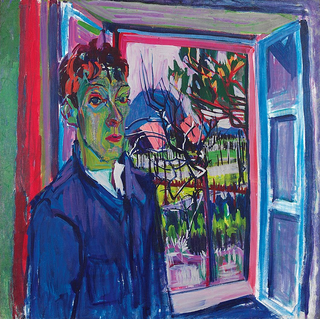
Albert Müller was a Swiss Expressionist painter, glass artist, draftsman, graphic artist and sculptor.

Hermann Scherer was a German-speaking Swiss Expressionist painter and sculptor.
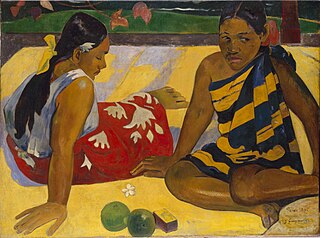
The Galerie Neue Meister in Dresden, Germany, displays around 300 paintings from the 19th century until today, including works from Otto Dix, Edgar Degas, Vincent van Gogh and Claude Monet. The gallery also exhibits a number of sculptures from the Dresden Sculpture Collection from the same period. The museum's collection grew out of the Old Masters Gallery, for which contemporary works were increasingly purchased after 1843.
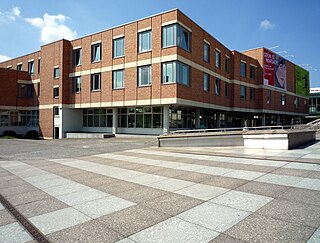
The Kupferstichkabinett, or Museum of Prints and Drawings, is a prints museum in Berlin, Germany. It is part of the Berlin State Museums, and is located in the Kulturforum on Potsdamer Platz. It is the largest museum of graphic art in Germany, with more than 500,000 prints and around 110,000 individual works on paper.
Annette Gigon / Mike Guyer Architects is an architectural office based in Zurich, Switzerland. It is led by the Swiss-born architect Annette Gigon and the U.S.-born architect Mike Guyer. Works by the office have been widely published and are admired for their formal logic and legibility, their sensitive handling of materials, and their skillful use of color.
Hans Danuser was a Swiss artist and photographer. His first major work, the cycle In Vivo, brought him international fame, therein he broke several societal taboos with respect to genetic research and nuclear physics. Since the 1990s, in addition to his photographic studies, Danuser has focused increasingly on transdisciplinary (research) projects in the arts and sciences.

Alfred Hess was a German Jewish industrialist and art collector.
Max Creutz was a German art historian and curator of the Museum für Angewandte Kunst Köln and the Kaiser-Wilhelm-Museum in Krefeld where he worked from 1922 until his death. In Cologne, in 1914 he was instrumental in the first exhibition of the Deutscher Werkbund, Deutsche Werkbundausstellung. In Krefeld, he succeeded in acquiring modern art exhibits, including works by Max Ernst, Wassily Kandinsky, and Alexej von Jawlensky. He included a substantial collection of art, crafts and design from the Bauhaus.

Alpine Kitchen is an oil painting on canvas by German artist Ernst Ludwig Kirchner, executed in 1918. It was made when the painter was temporarily living in a mountain hut in the Alps, at 1900 meters of height, above Davos. The house still exists almost in his original form. The painting came from Kirchner's estate and today belongs to the collection of the Thyssen-Bornemisza Museum in Madrid.
Roman Norbert Ketterer was a German auctioneer, gallery owner and art dealer.
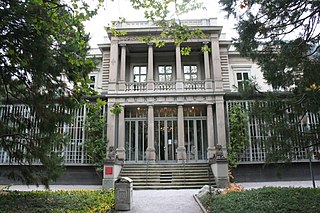
Bündner Kunstmuseum is a Swiss art museum founded in 1919, and located in Chur, Switzerland.

Archers is an oil-on-canvas painting by German painter Ernst Ludwig Kirchner, created in 1935–1937, at his Swiss home town of Davos. It belongs to his last phase, in which he abandoned the Expressionism of his earlier work. The painting depicts three people engaged in the sport of archery. On the back it bears the signature EL Kirchner. The painting is part of the collection of the Kirchner Museum Davos.
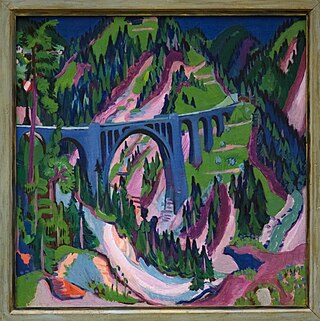
The Bridge near Wiesen, also known as The Bridge at Wiesen, is an oil-on-canvas painting by the German painter Ernst Ludwig Kirchner, from 1926. It depicts the Wiesen Viaduct, south of Davos, in Switzerland. It is signed on the bottom right of the center and is dated '26' on the back. The painting is held at the Kirchner Museum Davos.
Georg Schmidt was a Swiss art historian. He was director of the Kunstmuseum Basel from 1939 to 1961.















